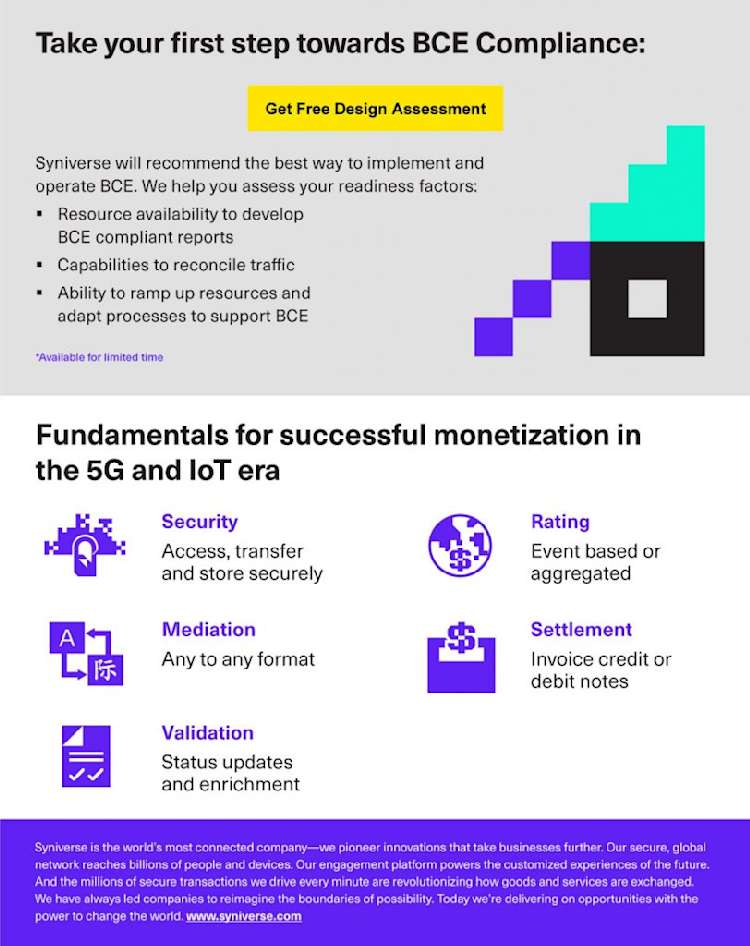Today’s next generations of technologies are revolutionizing not just the mobile industry itself, but also how the mobile industry enables others to grow as well, at an equally rapid pace. Clearing and settlement is clearly no exception, as the explosion in use case and business model variation dictates the need for the latest and greatest evolution in roaming monetization.
Enter the GSMA’s new billing and charging evolution (BCE). Designed with the future in mind, BCE introduces a new level of flexibility to charging models and settlement models, while reducing the need to send traffic data records daily and implementing new methods to handle wholesale charging. It also enables usage to be reconciled, leading to more accuracy in invoicing and faster settlement.
Syniverse has remained at the forefront of this technology, keeping a watchful eye on both the drivers and challenges that are shaping the future of the roaming market. In our most recent webinar, we spoke about how emerging tech, including 5G and the MIoT, are adding more connectivity and complexity to the clearing and settlement process, thus causing us — and the industry alike — to narrow our collective focus on the GSMA’s redefined standards, preparing for scalable growth.
With the Growth of Opportunities, Change is Coming — and Will Remain Constant
Prior to the GSMA’s development of the billing and charging evolution, clearing and settlement with Transferred Account Procedure (TAP) had proved itself as a successful standard, specifically for wholesale and retail billing of roaming, largely thanks to its availability. One-hundred percent of the industry adopted it — both by carriers and clearing houses — to facilitate a revenue stream and data exchange between operators around the globe.
The downside, however, was that there were a lot of moving parts within the commercial models, in terms of how companies were conducting business with each other, which led to multiplication of workstreams and higher costs. But with today’s emerging networks such as 5G, and with specific IoT use cases along with new business models, the industry realized that the time — and the market — was ripe for change with the rollout of a more flexible solution to support specific billing and charging requirements of commercial roaming models.
Take 5G as a real-life example. As Syniverse gears up for the readiness of 5G, BCE has followed suit, virtually in lockstep, as that too, has been designed specifically with 5G roaming top of mind. As that technology transitions from Non-Standalone (NSA) to Standalone (SA), there will be even more change; more partners and more commercial models needing to be integrated into the wholesale business model. BCE sets out to move that forward and overcome certain limitations that TAP may have currently to actually monetize 5G roaming that’s on par with today’s standards, including supporting potential models for charging by 5G network slice.

The GSMA’s BCE Standard Signals a Foundational Change, Not Merely a Trend
Syniverse is convinced that BCE is the future of clearing and settlement, for two reasons: currently TAP is in “maintenance mode” and will not be undergoing any enhancements, and second, there are no other current industry-approved alternatives. The standard was designed by industry representatives and technology experts contending with several new clearing and settlement challenges in being able to monetize new roaming services simply and efficiently. But already in 2020, we’re seeing a lot of progress in the implementation of BCE. Although BCE and TAP will still co-exist over the next several years, M2M/MIoT traffic is starting to be billed using this different process, while current data services are also being transitioned from TAP to BCE.
Syniverse Specifically Aims to Address Three Things: Speed, Accuracy and Efficiency
Today’s market faces many challenges. In addition to a multi-vendor ecosystem, traffic requires monetization, existing friction in business processes is a direct result of multiple input formats, and a lack of uniformity and audit capabilities render the entire process extremely rigid. Despite the inherent complexities revealed in the sheer number of obstacles, Syniverse has set out to change that, directly with Universal Commerce for BCE.
Instead of daily data files transferred through TAP, BCE reports are exchanged on agreed intervals between parties based on bilateral agreements. The aggregated volume in these reports are then used in support of wholesale invoicing and settlement. In cases where more detailed information is either required or in dispute, BCE makes it possible to also send Detailed Data Records (DDRs) to get out in front of non-aggregated billing records.
The Transition from TAP to BCE is Happening Now — and It Actually Isn’t Very Difficult
While readiness undoubtedly varies from operator to operator, practicality suggests that timing for shifting clearing and settlement practices from TAP to BCE should be opportunity-based. Think of monetizing for new traffic to supplement an IoT use case, or the ability to optimize commercial frameworks with partners for new services or existing data roaming services.
To get started, there are several approaches of implementation that are conditional for each business, including an in-house development model, or partner model, through which a solutions provider such as Syniverse becomes instrumental. Perhaps also facilitating this transition, as well, are the similarities between TAP and BCE, and the additional considerations that come with BCE.
As with TAP, TADIG codes are still used with BCE, as is the case with agents. Payment processes will also be the same (direct/netting), with no impact either on current fraud processes. BCE, meanwhile, features agreed-upon frequency of exchange between parties, which affects how notification files are sent, serving as an enhancement from TAP’s daily frequency. Settling disputes as well becomes easier than in TAP, with additional efficiencies derived from flexible invoicing periods, processes and billing statement reports to back up charging documents. There’s even potential to create a single invoice covering both BCE and TAP, rendering billing more streamlined from operator to operator.
Syniverse Can Help with This Transition as Early as Today
The future of roaming monetization is here—are you ready? Syniverse and its Universal Commerce solution has complexity covered, so customers can focus on their core business uninterrupted. Using a high level of automation, customers are able to access and transfer data securely from any format through a GSMA-compliant platform that makes the entire roaming monetization process frictionless.
No matter the various business challenges — ambiguity in commercial framework, disconnected workflows, billing disputes, or the exchange of heterogeneous data formats — Syniverse adds value by offering a consensus process, automated workflows, validation and compliance, and proof of applied business logic to perform reconciliation to enable customers’ business growth.
Interested? Click on the yellow button in the graphic below to fill out a complimentary Design Assessment form and receive our recommendation for the best way to implement BCE and assess your readiness factors.





